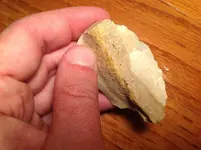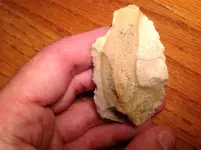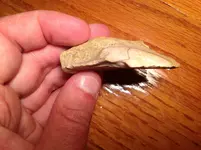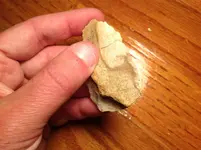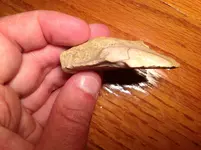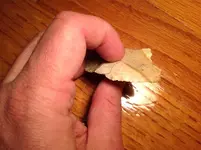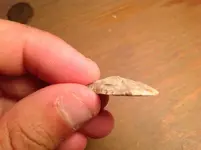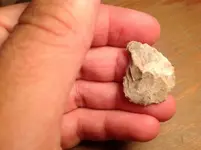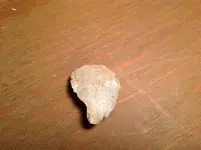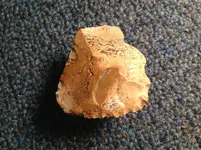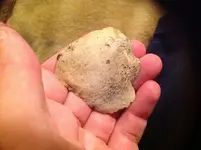You are using an out of date browser. It may not display this or other websites correctly.
You should upgrade or use an alternative browser.
You should upgrade or use an alternative browser.
Edgework Possibilities?
- Thread starter autographcollector11
- Start date
autographcollector11
Sr. Member
- #2
Thread Owner
Need picture of flat side, not seeing anything yet to say artifact....
quito
Silver Member
- Joined
- Mar 31, 2008
- Messages
- 4,626
- Reaction score
- 4,844
- Golden Thread
- 0
- Location
- south dakota
- Detector(s) used
- good eyes
Looks like a nice uni-face scraper to me.
rock
Gold Member
Not all flake tools are more than a chunk knocked off then some edge work put on them for a quick clean for the kill. The items they made with all of the flaking on them were the tools they planned on using over and over.
quito
Silver Member
- Joined
- Mar 31, 2008
- Messages
- 4,626
- Reaction score
- 4,844
- Golden Thread
- 0
- Location
- south dakota
- Detector(s) used
- good eyes
Not all flake tools are more than a chunk knocked off then some edge work put on them for a quick clean for the kill. The items they made with all of the flaking on them were the tools they planned on using over and over.
Amazing.
Edgework on flake tools, and on just about every other tool is simply just re-sharpening the edge.
What your describing here is 99.9% of the time just mother nature's natural work...Not all flake tools are more than a chunk knocked off then some edge work put on them for a quick clean for the kill. The items they made with all of the flaking on them were the tools they planned on using over and over.
We do a disservice to new hunters when we encourage them to collect natural rock because there is less than a 1% chance man may have touched it once in ancient times.
autographcollector11
Sr. Member
- #10
Thread Owner
So-would the edge work on this piece be man made or courtesy of nature?
monsterrack
Silver Member
- Joined
- Apr 15, 2013
- Messages
- 4,419
- Reaction score
- 5,827
- Golden Thread
- 0
- Location
- Southwest Mississippi
- Detector(s) used
- Garrett, and Whites
- Primary Interest:
- All Treasure Hunting
It is hard to tell if natural or man made without seeing the other side of this piece, like T hunter said. After reading this post the other day, a piece of gravel in a drive way at a oil plant caught my eye and made me think of this post. Edge chipping can come from a lot of actions, natural and man made. This piece if found in the right setting of camp sites or any other artifact type site, would be thought of as man chipped edge work, but it was made by trucks running over it for Lord knows how long. Another give away is that the chipping on the edge is to straight down and not more at a angle.
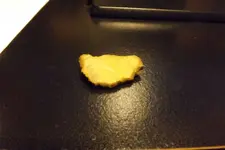
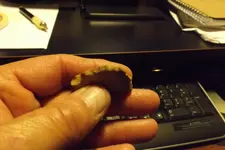 The best flake tool and this is JMO is the first edge that comes off when the flake is struck, it is razor sharp at this point. I have skinned and 1/4 a whitetail deer with such a flake and it was still sharp enough to cut you after all that work. This just a thought but why sharpen an edge when you could just make a new flake unless you did not have anymore stone handy, because it is a lot faster to knock off a flake than put a edge on one, just a thought.
The best flake tool and this is JMO is the first edge that comes off when the flake is struck, it is razor sharp at this point. I have skinned and 1/4 a whitetail deer with such a flake and it was still sharp enough to cut you after all that work. This just a thought but why sharpen an edge when you could just make a new flake unless you did not have anymore stone handy, because it is a lot faster to knock off a flake than put a edge on one, just a thought.


 The best flake tool and this is JMO is the first edge that comes off when the flake is struck, it is razor sharp at this point. I have skinned and 1/4 a whitetail deer with such a flake and it was still sharp enough to cut you after all that work. This just a thought but why sharpen an edge when you could just make a new flake unless you did not have anymore stone handy, because it is a lot faster to knock off a flake than put a edge on one, just a thought.
The best flake tool and this is JMO is the first edge that comes off when the flake is struck, it is razor sharp at this point. I have skinned and 1/4 a whitetail deer with such a flake and it was still sharp enough to cut you after all that work. This just a thought but why sharpen an edge when you could just make a new flake unless you did not have anymore stone handy, because it is a lot faster to knock off a flake than put a edge on one, just a thought.autographcollector11
Sr. Member
- #12
Thread Owner
Thanks Monster Track, etc-
Based on your response-I have a follow up question. take a look at the attached piece. this was found in the woods-specifically on a trail used for walking.it was just below the surface. I have founds a few nice tools in the area-but could this be from simple wear and tear?
It is clearly unifaced-but the surface looks clearly modified.
Thoughts?
Based on your response-I have a follow up question. take a look at the attached piece. this was found in the woods-specifically on a trail used for walking.it was just below the surface. I have founds a few nice tools in the area-but could this be from simple wear and tear?
It is clearly unifaced-but the surface looks clearly modified.
Thoughts?
Attachments
monsterrack
Silver Member
- Joined
- Apr 15, 2013
- Messages
- 4,419
- Reaction score
- 5,827
- Golden Thread
- 0
- Location
- Southwest Mississippi
- Detector(s) used
- Garrett, and Whites
- Primary Interest:
- All Treasure Hunting
From what I can see, there is evidence of other flakes taken off of this piece and the edge work could be from being walked on because the edge chipping is almost straight down or it could have been made that way. I for sure see were man altered this piece JMO.
autographcollector11
Sr. Member
- #14
Thread Owner
the responses intrigue me. one more review requested. Same scenario-found in the woods along a trail. One sided is "worked"
NA's did live in the area until 1836.
Looks pretty legitimate to me. Any signs that this could be due to wear/tear and not intentional flaking?
note that one side is unifaced with slight ripples-hard to see in the image....
NA's did live in the area until 1836.
Looks pretty legitimate to me. Any signs that this could be due to wear/tear and not intentional flaking?
note that one side is unifaced with slight ripples-hard to see in the image....
Attachments
monsterrack
Silver Member
- Joined
- Apr 15, 2013
- Messages
- 4,419
- Reaction score
- 5,827
- Golden Thread
- 0
- Location
- Southwest Mississippi
- Detector(s) used
- Garrett, and Whites
- Primary Interest:
- All Treasure Hunting
This piece looks more like pressure flaking, see how it goes back on the stone at a smaller angle, JMO it has been worked and what it was used for would be anyone's guess.
Similar threads
- Replies
- 9
- Views
- 791
- Replies
- 10
- Views
- 431
- Replies
- 19
- Views
- 980
Users who are viewing this thread
Total: 1 (members: 0, guests: 1)

